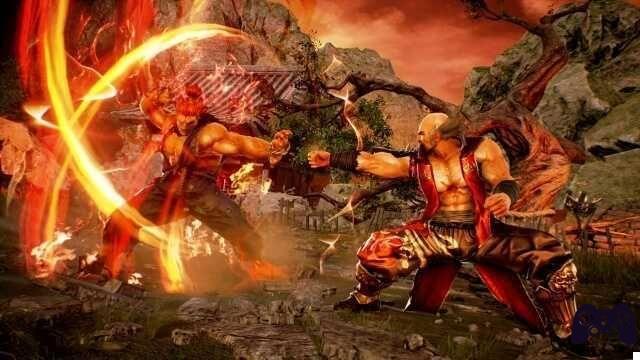- Page 1: Monster Hunter World Iceborne, the complete guide
- Pagina 2: Monster Hunter World Iceborne: Guida a Safi'jiiva
- Page 3: Monster Hunter World Iceborne: Guide to Namielle
- Pagina 4 : Monster Hunter World Iceborne: Guida a Yian Garuga
- Page 5: Monster Hunter World Iceborne: Zinogre Guide
- Page 6: Monster Hunter World Iceborne: Tigrex Guide
- Page 7: Monster Hunter World Iceborne: Glavenus Guide
- Page 8: Monster Hunter World Iceborne: Nargacuga Guide
- Page 9: Monster Hunter World Iceborne: guide to all subspecies
- Page 10: Monster Hunter World Iceborne: Barioth Guide
- Pagina 11 : Monster Hunter World Iceborne: Guida a Shara Ishvalda
- Page 12: Monster Hunter World Iceborne: Guide to Velkhana
- Pagina 13 : Monster Hunter World Iceborne: Guida al Brachydios
- Page 14: Monster Hunter World Iceborne: Banbaro Guide
- Page 15: Monster Hunter World Iceborne: Beotodus Guide
With the arrival of Iceborne, in Monster Hunter World the subspecies monsters: that is variants that belong to the same branch of the creatures known to us but that differ in appearance, abilities and characteristics.
These subspecies are a trademark of the saga of Capcom, bringing in its offer dozens and dozens of different ways to characterize monsters. Sometimes, these variants were even collaborations with other video games or franchises, such as the Kulu-Ya-Ku with the Final Fantasy crystal could be.
Being monsters that share many aspects with their basic version, at least as far as the more standard attacks are concerned, we have decided to write a single document where you will find useful strategies to better deal with these new species, exploiting their weaknesses and learning how they differ from the original version.
Pukei-Pukei Corallino
Il Pukei-Pukei Corallino he left the forest to find places full of water to swallow. While its jungle relative uses the poison it secretes from its stomach, the Coral Pukei-Pukei uses water sources to charge your digestive system and spray it everywhere, both from the mouth and from the opening of the tail. His body is much more resilient, and close combat appears to have been abandoned in favor of numerous ranged moves. From the mouth it is able to launch very fast jets in a straight line, dividing them with the tongue or accumulating water for large drops coming from the large jaw.
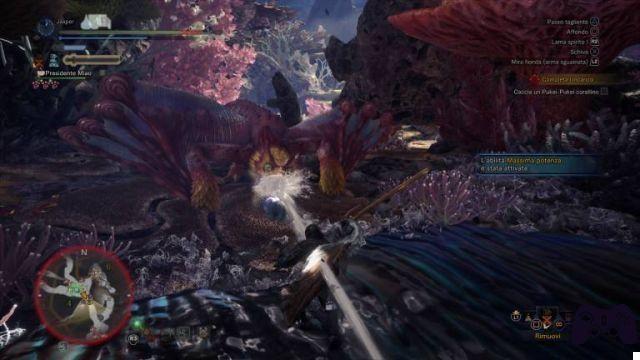
Using a weapon Thunder and Waterproof Cloak, this monster will still be very easy to beat. The difficulty lies in the large area of its water attacks: from the back it will emit a jet on the ground that will take almost everything that is in front of its tail, while from the head will start various waves of water with different directions and sizes. While many of the attacks are entirely predictable due to the bulges in the body, none of them pose a real threat to the hunter. Those who will find themselves most in difficulty will be the users of ranged weapons, who will be forced to find themselves in the middle of the attack area of the Pukei-Pukei Corallino. His is Ice.
Paolumu Onirico
As the name suggests, this black-coated Paolumu has adapted to the climate of the Forest, letting the air trapped in its pouch fill with soporific spores. Now with its jet it is able to create real permanent clouds able to put anyone who passes through it to sleep. As can be guessed, the best defense against this variant is the Immunity Cloak, which prevents any altered state for its duration. Use it sparingly and wait for it to swell before wearing it. Also bring a weaponAcqua, the element to which it is weakest.
Read also: Monster Hunter World Iceborne: Tigrex Guide
In case it manages to place the clouds, the Paolumu's attacks will have different effects depending on the state. The tails on the ground will sweep away the residue of air, dispersing the sleeping dust. If you can direct these attacks against the clouds it creates, you will make the battlefield much more manageable. At the same time, the air intakes cause the surrounding clouds to unite under the Paolumu, so stay away when the air begins to recharge.
Its largest move is a strong jet of soporific dust thrown directly on the ground, covering almost the entire area around his floating body. This attack is preceded by a big breath of charge, so take advantage of that moment to get away quickly with a dodge. Also remember that, despite being clouds, direct jets hurt regardless of sleep immunity, especially when they are very large area attacks.
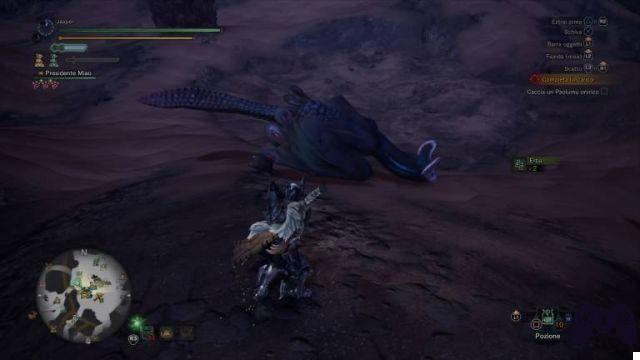
As for the Paolumu, when it is in the air, do everything to knock it down. Lightning pods they are particularly useful, especially since its vulnerability to flash also deflates the air pocket it has stored. So, if you're in a tight spot, use this opening to put him within reach. Closed Bows and Crossbows will find himself easier in this clash, while all the others will have to take advantage of the Grapple Claw to hit it even when it flies. The more you keep it on the ground, the more you will have the chance to win quickly and not suffer any altered state, especially considering that the Oniric Paolumu does not have many moves when it is walking on the ground.
Tobi-Kadachi Vipera
Il Tobi-Kadachi Vipera is a monster very similar to its original version, only that it loses its electric mantle for pgrease everything on the poison and on spines that can be thrown from the tail. Its subspecies possesses exactly the attacks that we all know, thus aiming at hitting you with the tail, using the soft skin to make short glides and climbing on rough surfaces from time to time.
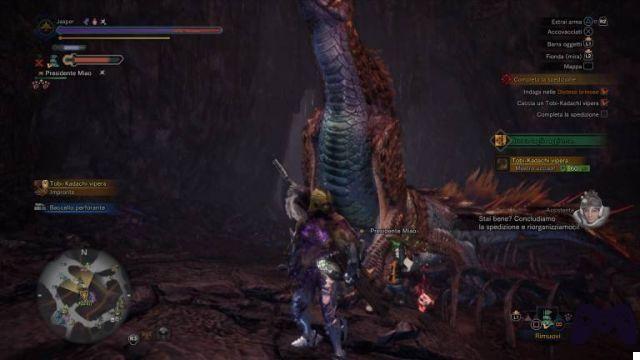
Always try not to stand in front of his attacks in order avoid the poisonous thorns he will throw, and always keep an eye on the tail when moving faster. Also remember that, being still a Tobki-Kadachi, he will be able to paralyze you if he hits you too many times with his poisonous teeth. So beware of his sudden attacks. Paradoxically it is weak just to the tone, so bring a weapon of that element along with a Immunity Cloak.
Legiana Glaciale
More than a subspecies, the Legiana Glaciale it can be considered as a natural evolution of a Legiana. In fact, an example of this variant has the same characteristics as its original version, only that it is able to create thick ice instead of simple frosty winds. As a result, its coat is more whitish in color and slightly larger in size, allowing it to fly much faster and longer.
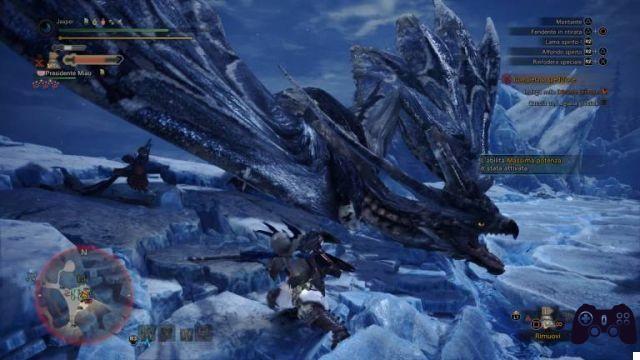
The Glacial Legiana during combat it will almost always be in flight, therefore i Lightning pods will be a must to deal with it, as well as a Mantello Antighiaccio and a weapon Fire. Its attacks create thick blades of ice on the ground, however anticipated by the same frost as a normal Legiana. In addition, he has several new attacks such as a violent landing that creates an area of ice around where his body crashes. Fortunately, such attacks are often preceded by a long animation, allowing you to move around and avoid taking damage. The rest of its moveset is the same as its less cold counterpart, so act accordingly and take advantage of the Grapple Claw to strike during the flight.
Caustic Glavenus
As the name suggests, the Caustic Glavenus is a subspecies of Glavenus that has settled within the effluvial habitats, transforming the heat of its body into pure solidified acid. Its tail is therefore not only much sharper than normal, given the absence of rock formations, but it is even able to cover itself with corrosive substances capable of lowering the defense of the prey. Of course, to face it in its natural habitat, it would be advisable to equip armor or jewelry Effluvium resistance to avoid the accumulation of this annoying altered status. At the same time it is also necessary to bring some Guscioduro and Nullbacche powder to counteract the reduction of Physical Defense. The Glavenus Caustic is also weak to Fire and Dragon, the latter gains further effectiveness when the monster "crystallizes" its tail.
This subspecies does not differ much from the original moveset when found in the crystallized form of the tail. The only lack is the absence of the magma that emits from the mouth, now absent in the effluvial variant. However, the situation changes when Caustic Glavenus loses its acid armor and shows its pure steel tail. This will not only be much more lethal and sharper than its fire counterpart, but being lighter it will allow Caustic Glavenus to make many more moves.
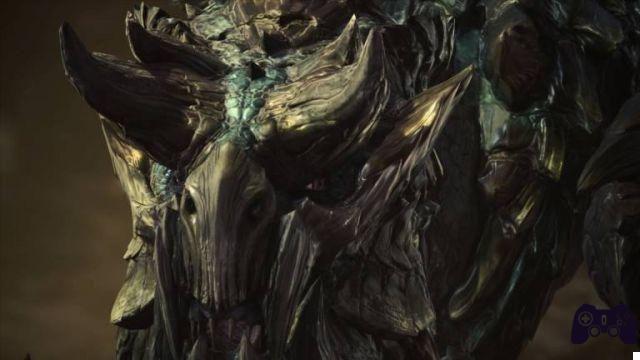
Continuous sweeps and combined blows will be incessant, but always signaled by the retraction of the caudal limb just behind the monster's back. So when you see Caustic Glavenus preparing its tail to attack you, even emitting a sparkle on the blade, be absolutely ready to dodge at the right time. Tail attacks will be tremendously powerful, so the advice is to avoid them instead of parrying or countering them. Also pay attention to its sideways movements, especially if you are safe under its hind legs.
Use Lightning Pods and traps in the hottest situations, destroying the mobility of Caustic Glavenus and allowing you to hit even the least reachable points due to the size. Also remember to use the slingshot ammo to unload it at the Glavenus' head through the Claw Grapple, so that it crashes into a wall and knocks it down.
Ebony Odogaron
If you thought the Odogaron was ferocious, you have no idea what awaits you in this black-mantled subspecies. Kind of like old Savage Deviljho, theEbony Odogaron it is a specimen that has come into contact with new biomes, becoming even more predatory due to the uncontrolled fury that runs through its veins. His moves are obviously those of a normal Odagaron but faster and less prone to bleeding.
The peculiarity of this black fair is the ability to be able to emit a corrosive breath of element Dragon, which means bring a Anti-Dragon Cloak it will save you from its altered status which will weaken your attacks (as well as make you vulnerable). This red breath is used both in melee moves, such as biting or sweeping, and as a ranged weapon that hits the ground during the beast's leaps.
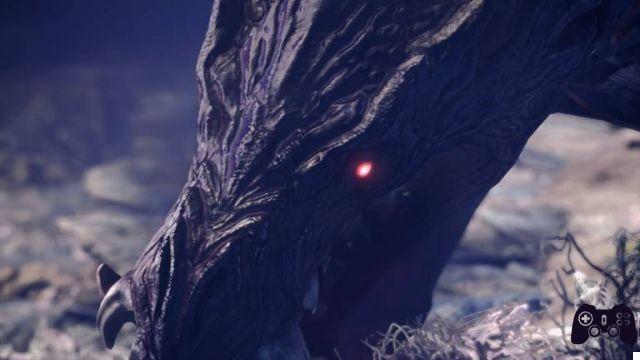
Usually, the ebony Odogaron will howl just before making some of its fiercest attacks, emitting red sparks in case they used the Dragon element. Also, when it happens to see him fall to the ground and get up again immediately to make the classic chain of 3 attacks and howl, remember that the ebony Odogaron will be able to make a further attack before stopping and giving you the opportunity to hit it. Finally it is weak to Water (3 stars) and to almost all other elements (2 stars) except Drago, with the distinction of having 3 stars in Poison and Paralysis. Take advantage of these two altered statuses to make the fight much easier and be very careful to get on his back with the Claw Grapple, considering the high attack speed.
Anjanath Tonante
The Anjanath is one of the toughest monsters in the experience of early Monster Hunter World players. With Iceborne, the challenge is repeated once again thanks to theAnjanath Tonante: a subspecies of the original monster that inhabited the Brine Wastes and acquired new properties. The biological structure has not changed: l'Anjanath the thunderous mucus and channels it to accumulate elemental charge for use as a ranged weapon and catalyst. Except that this subspecies, as the name suggests, left fire aside to switch to electricity, forcing hunters to equip a Insulating Cloak.
The Thundering Anjanath has several aces up its sleeve in addition to physical moves: it emits more mucus than its narrower cousin and uses the nasal appendages to launch short bursts of lightning in front of him. As the battle progresses, the wyvern channels more and more energy until it spreads its wings and envelops itself in a luminescent glow. In this state it will be able emit real energy beams hitting a large area of the ground, making it difficult to approach during the toughest attacks. Of course, he won't hesitate to use his large body as an offensive weapon either, throwing himself at his prey in lethal charges.
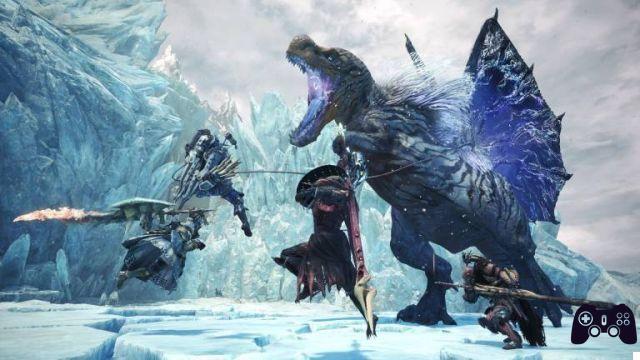
Due to its size, the movements of the Thundering Anjanath remain slow despite its new nature, thus allowing you to adopt the same strategies of the past. The point of divergence is obviously the raging state, in which you will have to beware of both the mucus it throws and the lightning that will surround it. The latter will often be visible just before they hit the ground thanks to the static on the impact points, a bit like the Kirin. Aim to break the nasal appendages, wings and tail, decreasing its offensive abilities considerably. Help yourself with weapons or Water or Ice, elements to which it is weak.
Volcanic Bazelgeuse
Defeating the Velkhana, you will find yourself facing another decidedly terrifying threat: the Volcanic Bazelgeuse. If you've already been having nightmares hearing his bomber song, this subspecies will shake your sanity with increased explosive power. The Volcanic Bazelgeuse gets its name precisely because it is capable of storing much more energy within its glands, creating purplish-colored mounds that create lethal outbursts for anyone within their range.
Equip yourself in a Fireproof Cloak and weapons Ice / Water for the fight, as well as any healing items you can bring along and a good one Fire Elemental Defense. The slightest inattention can be fatal to you, especially if you do not take into account the cocoons that continually detach from the abdomen and tail. Aim immediately to cut the latter to decrease its offensive capabilities and use the Lightning Pods when you see that it is starting to fly to start the bombing. Avoid standing in front of him for too long as most of his attacks will be frontal slams or jets of fire from the mouth, so prefer the hind legs and the tail area.
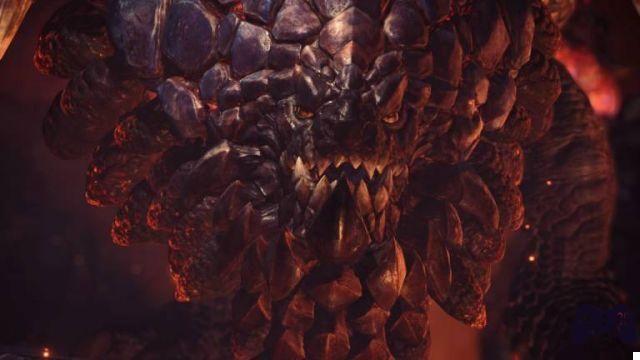
Il Volcanic Bazelgeuse has a unique attack compared to its original version: after accumulating a huge amount of energy - reported by the blue color of its explosive glands - will fly in the sky releasing cocoons around the arena, and then violently crash to the ground with a detonating force equal to an atomic bomb, discharging everything that had accumulated in the body. It goes without saying that this attack will be fatal if taken in full, so run. Run as fast as you can for your salvation.
Vaal Hazak Funereo
The first variant of Elder Dragon you will encounter will be that of the monster introduced with Monster Hunter World, which seems to have left the Rotten Valley to settle in the Ancient Forest. Contact with nature has changed its mantle, allowing it to grow spores and emit scents. This greatly enhanced his viral ability, making him an even greater threat than the Arch-Hardened version of the monster.
Don't think you can win this match without Effluvium Resistance at level 3. Use jewels and equipment with this property, along with a Immunity Cloak for safety and a supply of Nullberries / healing items. Weakness to Fire was inherited from this subspecies, along with that Burst and Dragon, but only have 2 stars, making our dragon more tough. The attack patterns are also roughly the same: the Vaal Hazak Funereal will emit rays and clouds of effluvium from your mouth, creating puddles where your greeting will decrease visibly. The difficulty in this fight lies in the pockets of Spores that the monster has sprinkled all over the body. The latter will emit jets of effluvium that will hit you despite the resistances, thus making it difficult to be close to it from any angle.
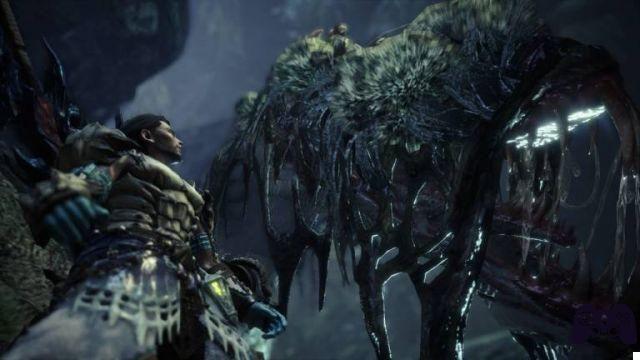
Use the Elder Seals and elemental weaknesses to quickly get rid of the sacs and aim to break his head to uncover his eyes and make him weak to the Lightning Pods. The best way to win the fight is to figure out exactly what his animations are and see where to hit and when. In general, being able to keep up with him during the front jets will provide you with ample room to maneuver for attacks, given that at some point it will soar into the sky and fill the arena with lethal scent. When that happens, absolutely run out of the area and try to get the monster to move away from the contaminated ground.
Rabbioso Brachydios
Extremely difficult subspecies of Brachydios, which maintains the weaknesses / resistances of its basic counterpart but takes on new connotations in the moveset. This specimen is capable of placing much larger explosive oozes, as well as detonating them on command even from a distance. His attacks are ferocious and tend to be more aggressive than normal, so much so that its most frequent attack is a frontal charge followed by a trail of explosions in a straight line, which is occasionally repeated three times in a row. It goes without saying that almost any move can reset your life or reduce it to a minimum and the blast state it applies with the slime is much more difficult than normal.
To better deal with this clash it is therefore advisable use an Insulating Cloak to avoid too many problems and aim above all to weaken the limbs and the tail, which must be cut as soon as possible. When his life drops below a certain threshold, he will say to an area where he will consecutively slam his fists on the ground and it will create a potentially explosive field of fire, overloading his body and emitting a high-temperature vapor. This phase of the fight is the potentially most dangerous one considering that the Brachydios will be able to explode all the slimes with a roar, even depriving you of the possibility of using any trap. So bring plenty Dust of Life and Lymph to avoid unpleasant inconveniences. Also watch out for the move that creates all explosive oozes around him for almost the entire radius of the area in which he is: the chains of explosions will be 3 and can be dodged simply by rolling in the opposite direction to the direction of the bursts.
Furious Rajang
Extremely difficult subspecies of Rajang, which is characterized by the perennial overloaded state of the monster. This devil with a yellow mantle keeps all the moves of the basic counterpart, but it enhances them dramatically thanks to its growing aura. The new attacks of this monster consist of more energy bursts than the possibility of create thunder snakes in a cone in front of him and larger elemental explosions when he makes his attacks from above. His "grip" has also been enhanced with a longer animation and more merciless hits.
The fight against this specimen is therefore of pure brute force. The first thing to do is ferect it with the claw grapple and use any altered staot / trap to hold it steady and hit it in those few seconds it stops. The strategy is therefore the same as that applied against the Rajang, only in this case any moderately powerful attack will be fatal, especially the energy emissions.
This guide is constantly updated, also including the various updates!
If you haven't participated in the hunt yet, Monster Hunter World and Iceborne are available on Amazon!





